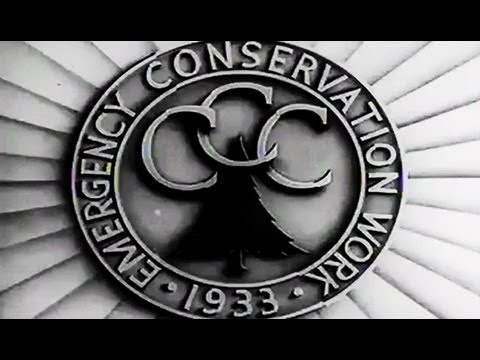more at
“The Department of Interior takes a look at its effort in the Great Smoky Mountains in this vintage film.
SUMMARY
Civilian Conservation Corps (CCC) men ride in trucks, work with pick and shovel, operate bulldozers, graders and pneumatic drills, construct parapets and guard rails, and march with pick and shovel in the park. Included are views of forests, flowers, and underbrush. Rangers in towers watch for forest fires.”
NEW VERSION with improved video & sound:
film transcript:
Public domain film from the US Interior Department (via National Archives), slightly cropped to remove uneven edges, with the aspect ratio corrected, and mild video noise reduction applied.
The soundtrack was also processed with volume normalization, noise reduction, clipping reduction, and/or equalization (the resulting sound, though not perfect, is far less noisy than the original).
The Great Smoky Mountains are a mountain range rising along the Tennessee–North Carolina border in the southeastern United States. They are a subrange of the Appalachian Mountains, and form part of the Blue Ridge Physiographic Province. The range is sometimes called the Smoky Mountains and the name is commonly shortened to the Smokies. The Great Smokies are best known as the home of the Great Smoky Mountains National Park, which protects most of the range. The park was established in 1934, and, with over 9 million visits per year, it is the most-visited national park in the United States.
The Great Smokies are part of an International Biosphere Reserve. The range is home to an estimated 187,000 acres (76,000 ha) of old growth forest, constituting the largest such stand east of the Mississippi River. The cove hardwood forests in the range’s lower elevations are among the most diverse ecosystems in North America, and the Southern Appalachian spruce-fir forest that coats the range’s upper elevations is the largest of its kind. The Great Smokies are also home to the densest black bear population in the Eastern United States and the most diverse salamander population outside of the tropics.
Along with the Biosphere reserve, the Great Smokies have been designated a UNESCO World Heritage Site. The U.S. National Park Service preserves and maintains 78 structures within the national park that were once part of the numerous small Appalachian communities scattered throughout the range’s river valleys and coves…
The name “Smoky” comes from the natural fog that often hangs over the range…
The Civilian Conservation Corps (CCC) was a public work relief program that operated from 1933 to 1942 in the United States for unemployed, unmarried men from relief families, ages 18–25. Robert Fechner was the head of the agency. A part of the New Deal of President Franklin D. Roosevelt, it provided unskilled manual labor jobs related to the conservation and development of natural resources in rural lands owned by federal, state and local governments. The CCC was designed to provide jobs for young men, to relieve families who had difficulty finding jobs during the Great Depression in the United States while at the same time implementing a general natural resource conservation program in every state and territory. Maximum enrollment at any one time was 300,000; in nine years 3 million young men participated in the CCC, which provided them with shelter, clothing, and food, together with a small wage of $30 a month ($25 of which had to be sent home to their families).
The American public made the CCC the most popular of all the New Deal programs. Principal benefits of an individual’s enrollment in the CCC included improved physical condition, heightened morale, and increased employability. Of their pay of $30 a month, $25 went to their parents. Implicitly, the CCC also led to a greater public awareness and appreciation of the outdoors and the nation’s natural resources; and the continued need for a carefully planned, comprehensive national program for the protection and development of natural resources.
During the time of the CCC, volunteers planted nearly 3 billion trees to help reforest America, constructed more than 800 parks nationwide and upgraded most state parks, updated forest fire fighting methods, and built a network of service buildings and public roadways in remote areas.
The CCC operated separate programs for veterans and Native Americans.
Despite its popular support, the CCC was never a permanent agency. It depended on emergency and temporary Congressional legislation for its existence. By 1942, with World War II and the draft in operation, need for work relief declined and Congress voted to close the program…

